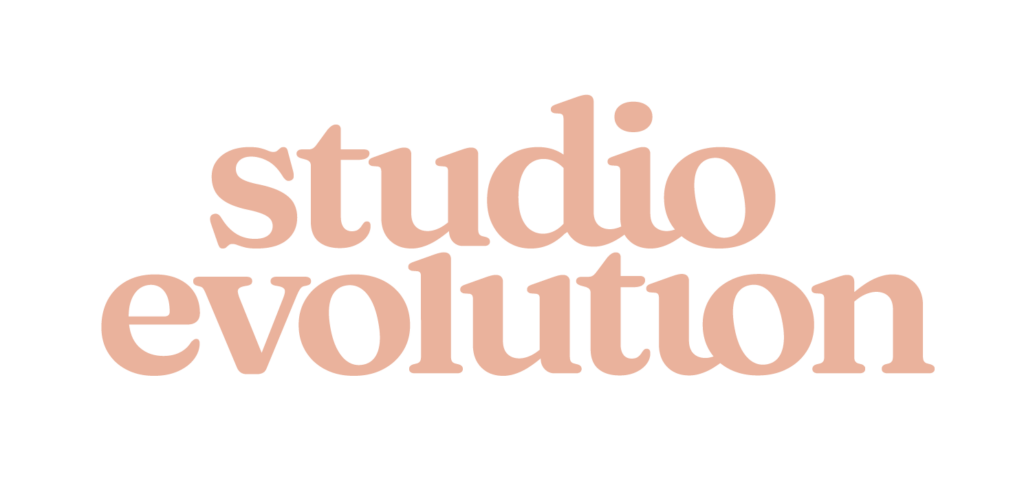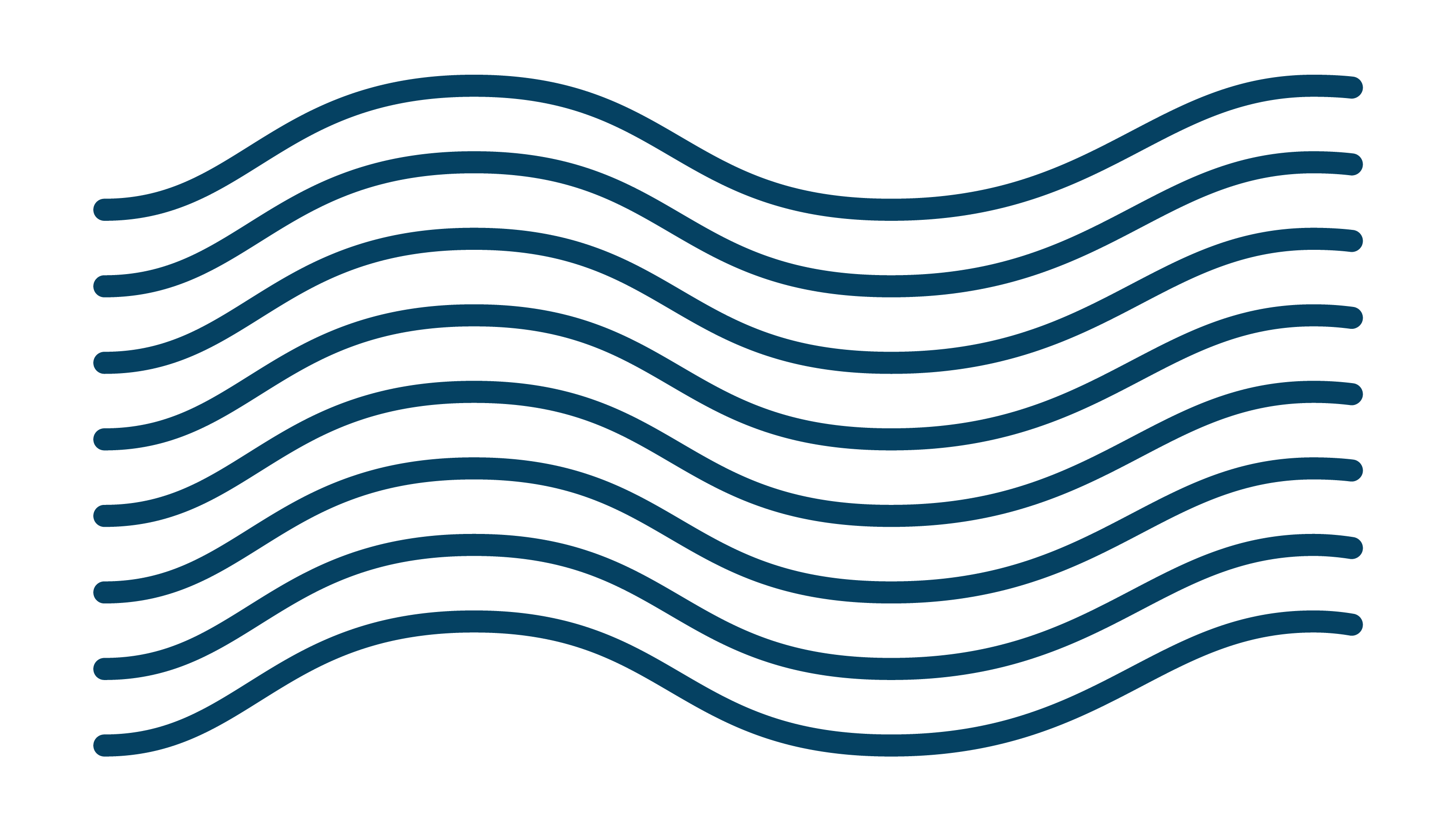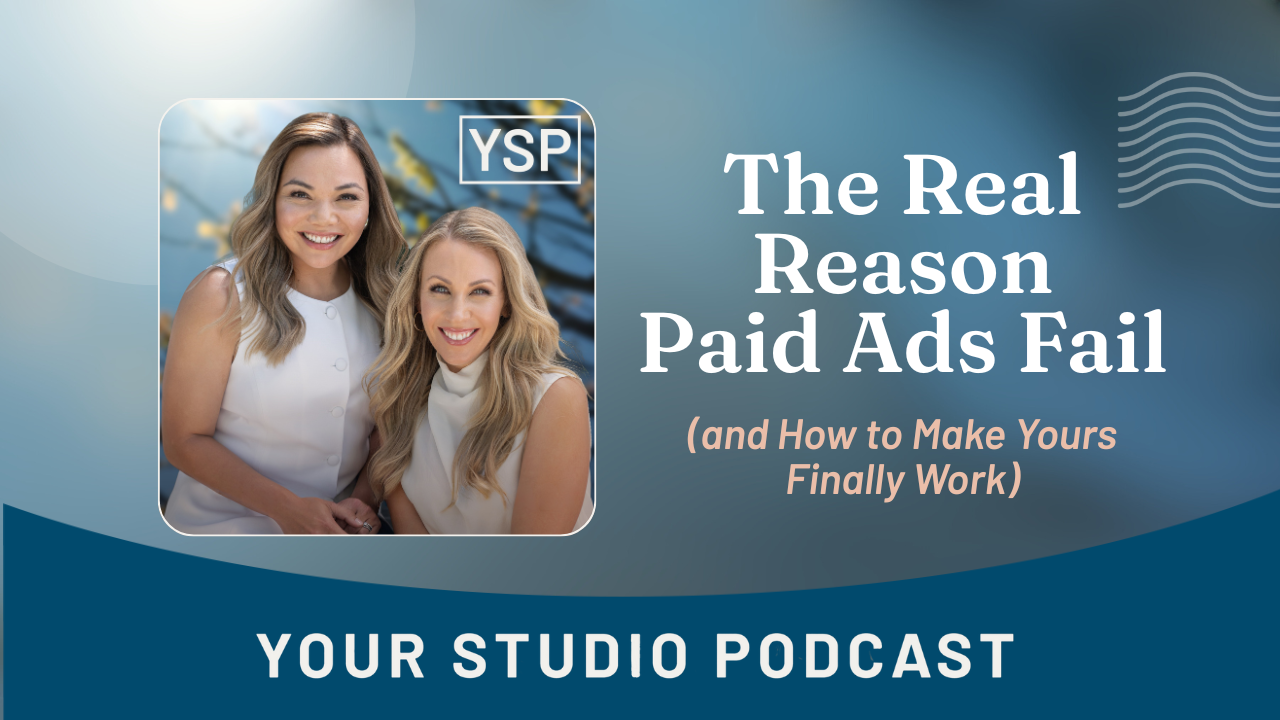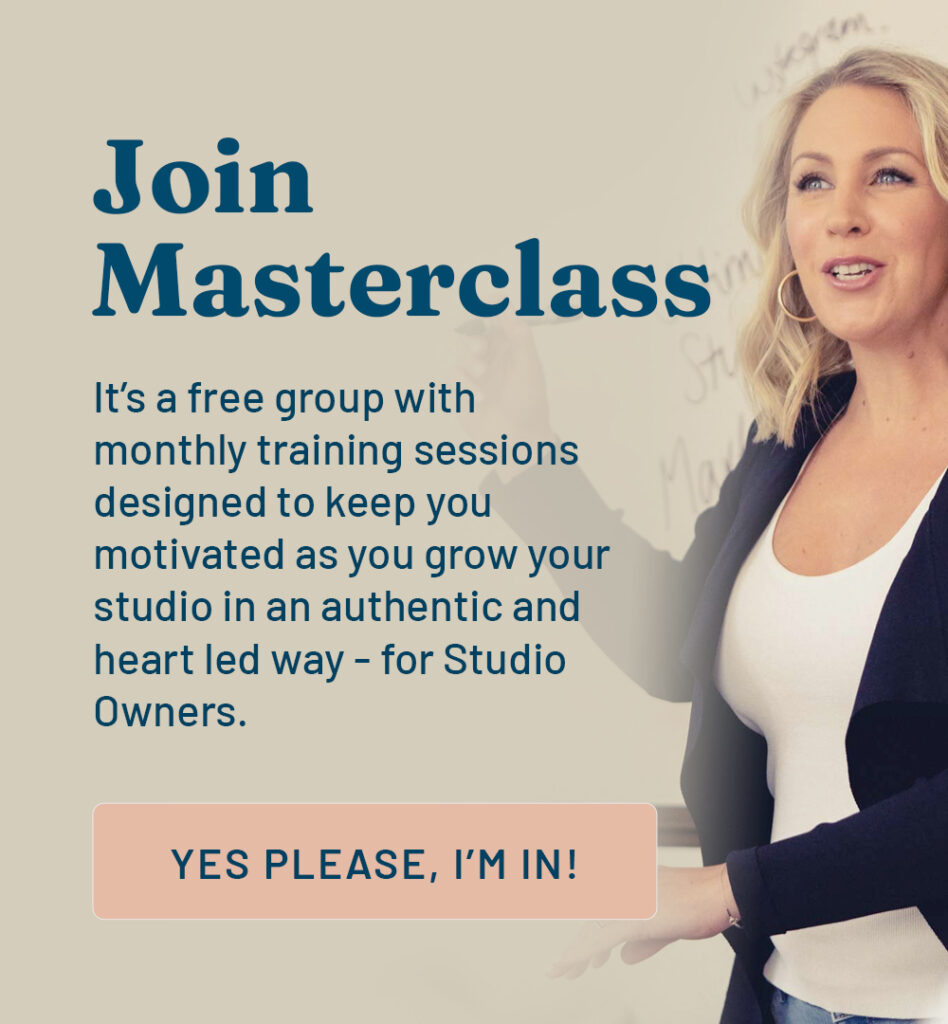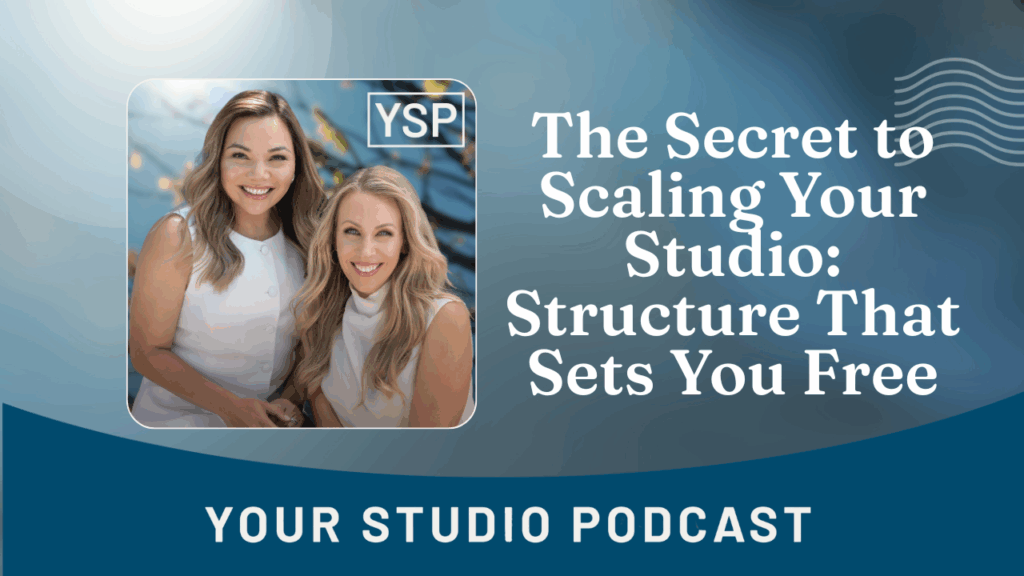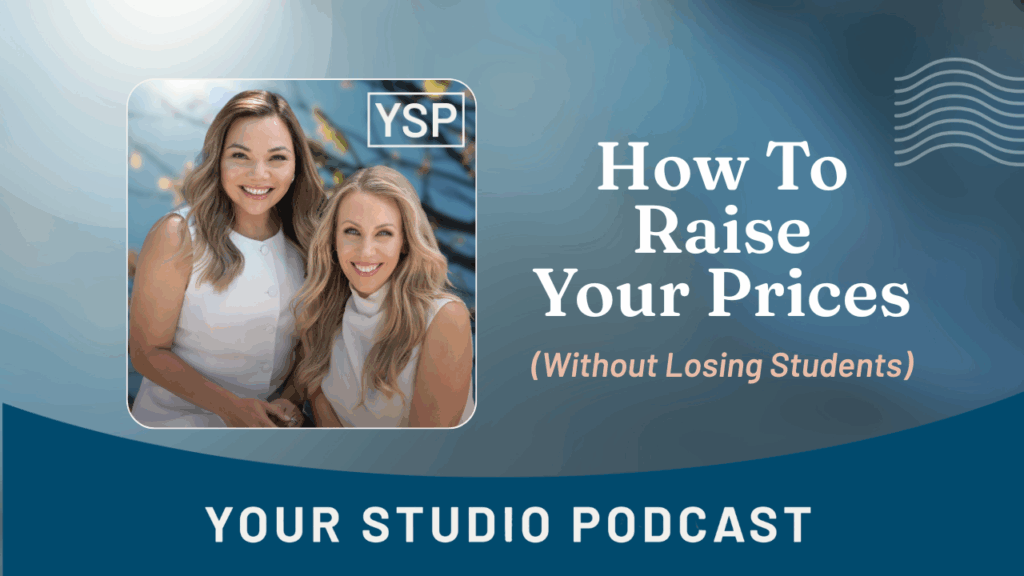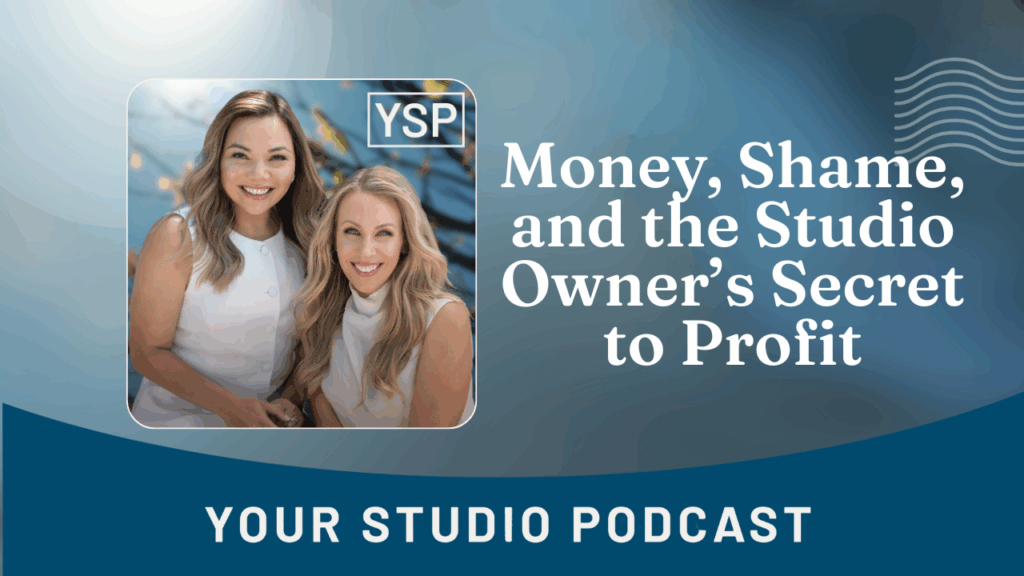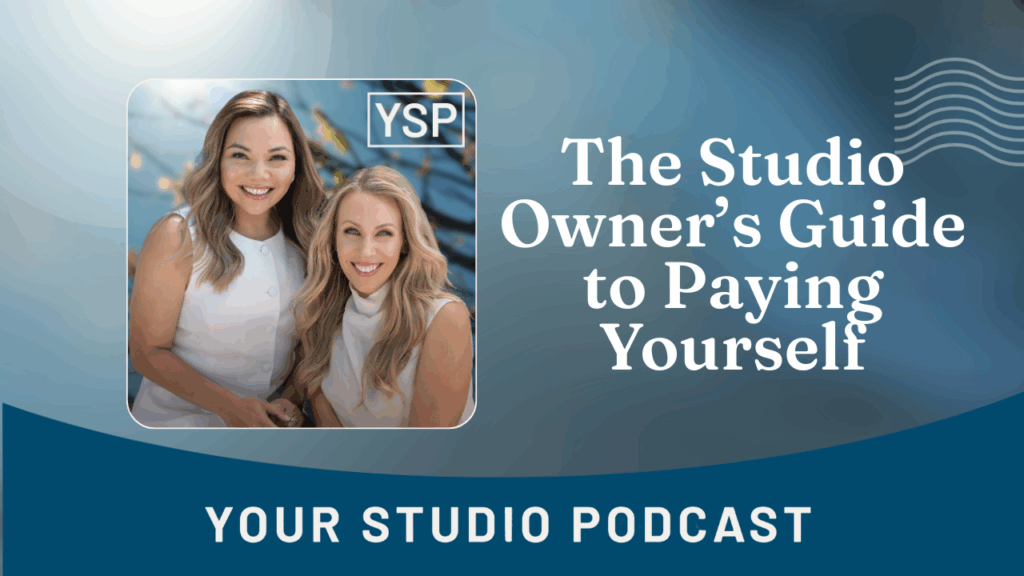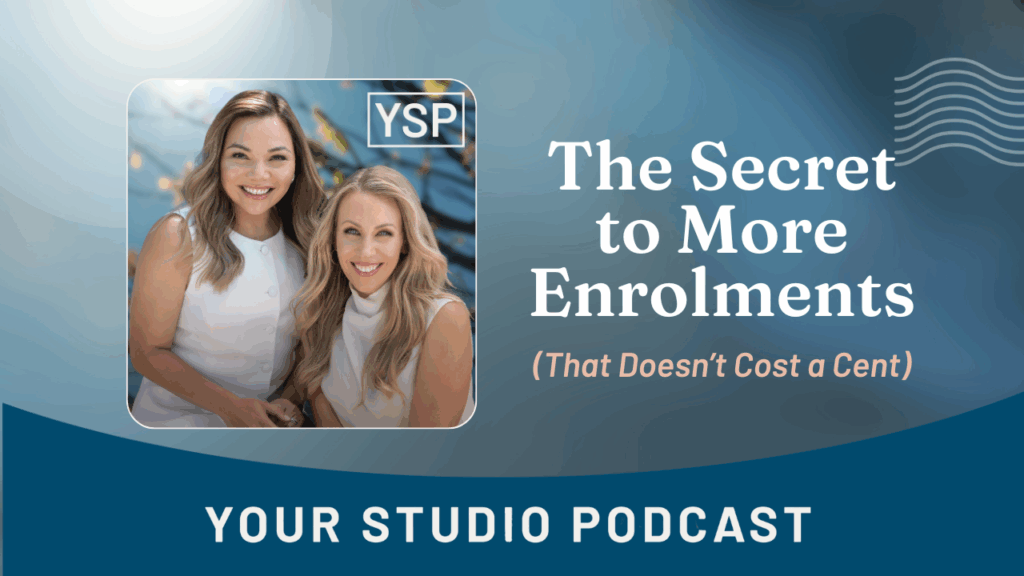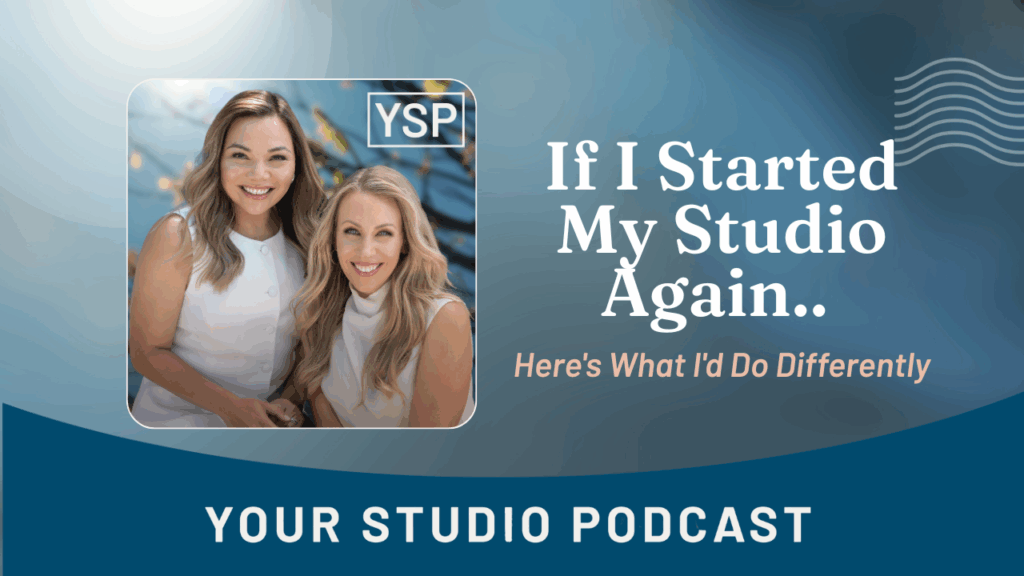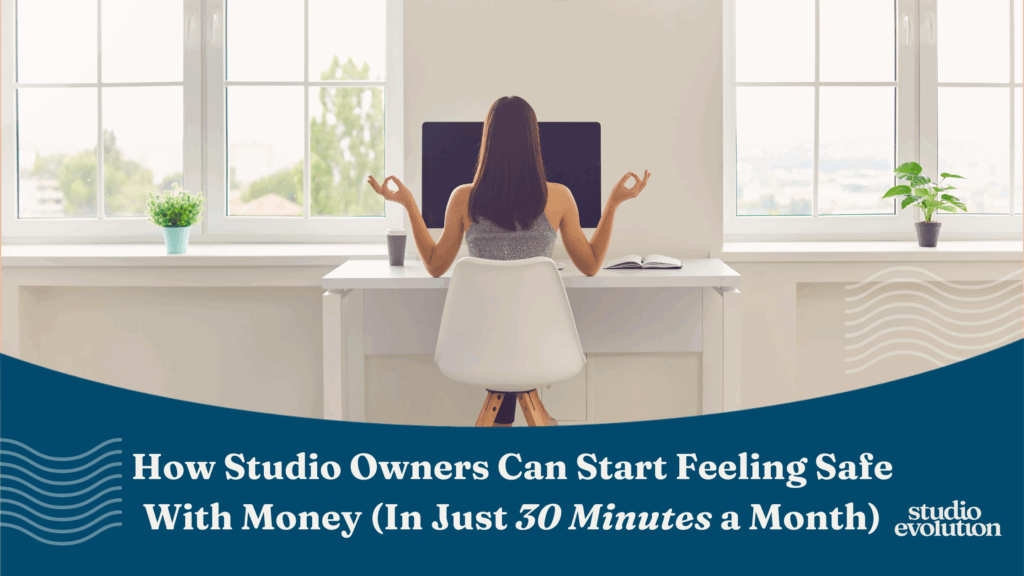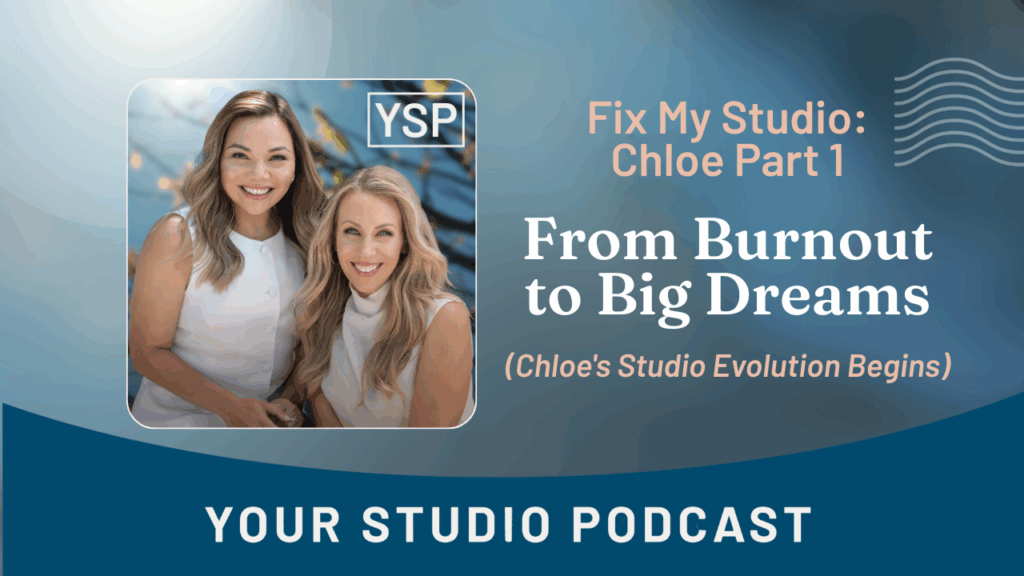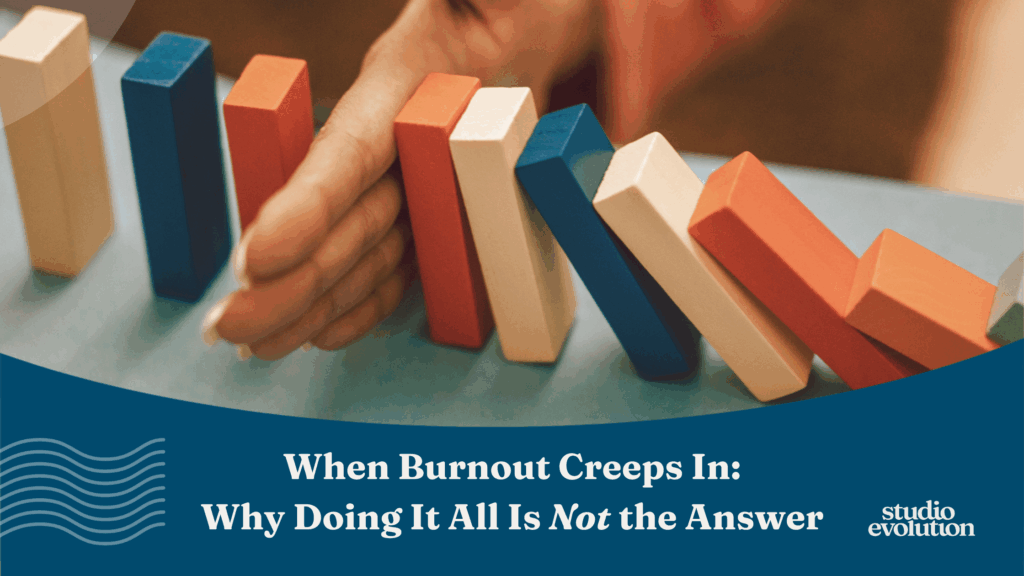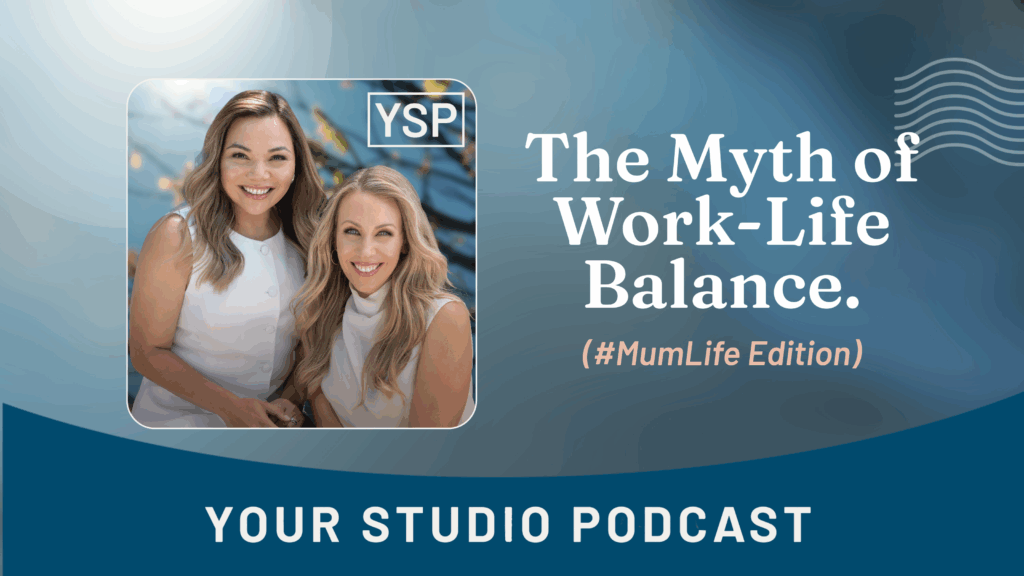If you’ve ever poured money into Facebook or Instagram ads only to hear crickets, this episode is for you. 🎧
Chantelle Bruinsma and Michelle Hunter unpack why paid ads often fail to bring new students — and the simple marketing shifts that actually make them work. Discover how to rebuild your website into an enrolment engine, attract your dream students, and create a marketing flow that feels effortless, heart-led, and effective.
Please subscribe + review!
Voicemail: https://www.speakpipe.com/LeaveEvolutionAVoicemail
Instagram: @thestudioevolution
YouTube: @thestudioevolution
Facebook: @TheStudioEvolution
Website: studioevolution.com/start
Chantelle Bruinsma (00:04):
Welcome to Your Studio Podcast, sharing strategies for studio owners. I’m Chantelle Bruinsma here with Michelle Hunter, and together we’re the CEOs of Studio Evolution, where for over a decade we’ve helped thousands of Studio owners around the world of dance, music, acting, art, yoga, and Pilates studios transform their passion into thriving profitable businesses. So if you’re a studio owner, grab a cup of tea and settle in. You’re in exactly the right place.
(00:31):
Hello, lovely ones. How are you doing? It’s Chantelle Bruinsma here, and I’ve got Michelle Hunter and this is Your Studio Podcast and we are so delighted to have you here. How are you, Michelle? I know you’re not a hundred percent. I’m here.
Michelle Hunter (00:50):
Oh, I’m at about 54% uploading as my computer is saying right now.
Chantelle Bruinsma (00:57):
So precise. So precise. Yeah. Soldiering
Michelle Hunter (01:00):
On another day, another cold with a toddler and kids, but we’re in the last stint near school holiday, so we’re going good.
Chantelle Bruinsma (01:10):
Hang on, hang on, hang on. Well, we are really excited about this conversation we want to have with you today because it’s a very common one that we have, and I understand why there is a real push. I’m sure you feel it in yourself to get large scale ad strategy happening, get advertising, get paid ads happening on social media and get more students in the studio. And if you’re like a bunch of studio owners, I know you’ve maybe tried ads, you’ve thrown a couple of hundred bucks of ads and it was just an absolute disappointment to say the least, right? Michelle? Nothing happens.
Michelle Hunter (01:44):
Nothing happens, and they think it’s the magic pill. People think if I just do paid ads, I’m going to get a whole influx of students. It’s going to fix everything. It’s going to fix all my problems.
Chantelle Bruinsma (01:55):
But for a lot of studios, they don’t work. They don’t work. But in this episode, we want to kind of reverse engineer why
(02:01):
And what to do to fix it because ads are not a magic wand. In fact, what we know for sure about ad strategy is it’s kind of going to reveal if your marketing isn’t strong, it’s just going to expose it. So if there are cracks in your process of enrolling students, walking ’em through the website, it’s going to just amplify that and throw money at it, which is what we don’t want to do. So our advice kind of first off the bat in the leap is we work with you to make sure your marketing is actually effective because there’s no point chucking cash at marketing that’s not working right? A leaky bucket is only going to get more leaky if you pour more water in. So when you got to make sure your marketing is working first before we really shouted out your megaphone to your community.
Michelle Hunter (02:56):
So when you say marketing Chantelle, what are you doing first and foremost with ’em? It’s like how they’re selling, how they’re selling, or is it the format of their website? What are we going to dive into here?
Chantelle Bruinsma (03:07):
Hold up. We’re going to go even further back. So I mean, the first thing is understanding. There’s probably a bunch of Pilates studios in your area. You’ve probably got some competitors doing dance studios, doing music tools. There’s probably people in your area offering similar service. The thing is that you’re different, and I want to know how, because the truth is that someone’s going to jump onto your website or see one of your ads, and really they’re basing this decision around, do I belong here? Is this somewhere a studio that I feel like I am, these are my people, this is aligned with what I’m seeking for myself. And if we’re all just doing the same low level bullshit, fun, friendly lessons,
(03:49):
You are absolutely sabotaging yourself. So first of all, we have to understand who are you, what do you care about? What do you stand for? How are you different than the others down the road, right? Then we need to find the match. It’s kind of like you are, and you’ve got these dream students that you’re wanting to connect with. For me, it’s like a sonar system. You are putting out this little beaconing, beep, beep, beep, this is who we are, and then the students are looking to pick it up like, oh, I hear that kind of ping and I want to jump on board with that. But if you are not speaking to what they’re looking for, it just gets lost in the wash. So it is two pronged to first of all begin with, I need to know what you stand for and what you don’t stand for, what you’re against people experiencing.
(04:36):
And then for us to really understand who is it that we’re targeting? Because there’s so many different kind of demographics within your area, people who care more about more performance opportunities, people who need more nurturing, people who want more personalized attunement. It depends what you really excel in delivering, and we need to bring that message more to the front. Now, if we need to understand that from a conceptual perspective, and then we need to get that shown and crystal clearly explained on your website and in all your marketing materials, and that again, can be tricky, right? Because you just feel like it’s hard to convey it across into a different platform. So the first thing I want to work on is largely your website, because usually what happens is that all roads lead back to it. So if we’re going to put an ad out, we’re going to put a flyer out, we’re going to put some socials, probably the main enrollment flow happens through the vehicle of your website, and if that isn’t designed well then throwing ads at it ain’t going to fix it either, right? It’s only going to be a waste of money. Does that make sense, Michelle?
Michelle Hunter (05:48):
100 percent. And if you’re a studio owner who’s been around the block for a long time, Chantelle, so they’ve been owning their studio for 10, 15 years. Sometimes I think going back to what makes them different and their values of who they want to attract is kind of like a hard exercise to do because they’ve kind of just been lost in the wash, in the right race of just trying to get people in, trying to get people in. Sometimes it’s hard to reconnect.
Chantelle Bruinsma (06:12):
Do you know what though? I reckon too. I think you’re bang on think you’re spot on that it’s hard to go back and look at it. The other reason I think it’s hard is because when you’ve been around the traps for a while, you are a bit blase with it all too, right? It’s like that kind of the ambivalence of what’s the body point? I work so hard, it doesn’t work. And so you passion your connection with who you are. Sometimes we need to reignite our passion for what we do and to reconnect with why we’ve done this in the first place and get excited about what we deliver. Again, if you are not excited, how do you expect anyone else to be? Right?
Michelle Hunter (06:47):
And it comes through in your messaging in your marketing. If you’re excited and you have reignited that passion, it does feed out.
Chantelle Bruinsma (06:56):
So that’s what I feel starting with that. I know it’s the basis of all marketing and it kind of sounds wishy washy, but it’s the truth. You can feel when people are just doing generic level advertising. I can see an ad for a studio and go like, it’s a dime a dozen. It shows me nothing, and it makes you invisible is the tricky thing. It makes you invisible in how you present because you are not different. And so if you are going to put ads, if you’re going to throw money and your ads, your marketing still feels generic, stop, abort, pause.
Michelle Hunter (07:35):
So when we talk about a website, I think in studio business it’s probably got to be one of the industries where if a parent or a student is interested, they’re going to look at your website. We are in an industry where I guess you could say your website is the enrollment machine, and can you talk about a bit more of that Chantelle and stress that because we know a lot of people when they come and work with us or we have chats, I just don’t have time to update my website. It’s just not a priority, but I think you really need to make it a priority.
Chantelle Bruinsma (08:03):
100%. Look, the truth is, here’s what’s happening is that someone is considering a studio for classes and they’re thinking about enrolling, they’re going to socials, they’re searching, they’re going to Google, they’re searching and they’re bringing up a bunch of different ones, and they’re going to research. They might go to three different websites, and the website that wins is the website that connects the best. Half the time. Majority with Studio websites that I see are lacking in connection, lacking in conveying belonging because they just talk about what they do. They just talking about the genre and saying, in the comfort zone of our teachers have these qualifications. Our facilities have these resources. We teach this type of genre, which is characterized by these types of things, and it’s got nothing to do with the student, nothing
(09:02):
That’s making them feel a sense of belonging, nothing that’s giving them a sense of connection. Nothing that’s human, nothing that’s speaking to their desires or dreams or aspirations or fears or what they would need to overcome or what their objections are. It’s got nothing to do with the decision making journey. It’s like, here’s what we do on a platter. Take it or leave it. And there’s no psychological nurturing. There’s no emotional kind of investment in helping the person make the decision to choose this studio over the others down the road. Most studio websites I see are just so brief and they’re so flat and they’re so logistical, but there’s no heart. There’s no invitation into what really is what you do, which is this beautiful transformation. It’s like such a missed opportunity. Your website is this chance to really speak to their hearts. I know what you deliver in the classroom is magic. Can you bring that magic to your website? I bet it’s not. I bet it’s not.
Michelle Hunter (09:58):
That’s actually really interesting, the effort you put into your classroom, let’s put that into your website.
Chantelle Bruinsma (10:03):
Oh my God, if I could just take everyone off class for a week and just sit down with you and just get your website actually feeling like an embodiment of who you are, not just using the generic just fun, friendly lessons from, it’s just we need more. We need to be speaking to what they’re wanting. And so what happens is that you might put an ad up, right? Here’s the other thing. A lot of ads I see are just promoting all the services in the studio.
(10:30):
So come to our reformer mat breathwork yoga classes come to our, we’ve got jazz, ballet, tap, hip hop, contemporary Tinies classes. We offer piano, guitar, music, early childhood. We offer all the things, if ever I can. One thing you can take from this podcast episode, if I can give you one bit of advice, it’s this, never ever, ever, ever, ever do a paid ad for more than one product, more than one program. You are only allowed to ever do an ad for one program. It must be speaking to the heart of the perfect dream student for that program, and it must perfectly articulate the experience that they are looking for when they’re wanting to enroll in that program. Otherwise, we are just chucking cash down the drain.
Michelle Hunter (11:21):
Yeah
Chantelle Bruinsma (11:21):
You’re trying to appeal to all different people with different desires, you’re going to get no one. You’re going to get no one. And it’s so disappointing. And then what happens? They do a kind of generic ad kind of promoting all the programs and they send them to their homepage. Now in online marketing, that is the worst number one, no, no thing you can do, Michelle. It’s like disaster.
Michelle Hunter (11:42):
Disaster. If you’re sending them to the homepage, you might as well not run the ad. You are either going to be running them to a dedicated page that’s focusing on that specific messaging and program, or you are sending them to somewhere where you’re going to capture the lead and nurture them properly. It’s got to be one or the other.
Chantelle Bruinsma (12:00):
So what that means, and this is what we teach in the Leap, just to be really, really clear. So in the six week course, we actually kind of give you everything to make this entire strategy flow it. It’s what we call a program page. So a page on your website that is devoted to that one program, and you’re speaking about who this program is perfect for and what this program stands for, what it stands against and what they’re going to receive and what they’re going to gain, and then how many weeks you’re going to notice this amount of change and you stack the value and you speak to what they’re going to expect and what parents love, and you literally kind of build out an entire ecosystem for one of your programs. So I want you right now on this call to think about, okay, what would be the program that for you would make the most sense to build this ad strategy out for, right?
(12:45):
If we could get one program in your studio field, which program would that be? Now, usually it’s kind of like an entry level program for your beginners or for the younger kind of demographic in your studio. We start with that. So we create an ad that speaks not just like, here’s what we do, but you speak actually to the heart of what that student is seeking, and it’s usually not sprung floors or brand new reformers. It’s nothing to do with that yet. It’s different. And then you take them, they click that they’ve expressed interest. I’m interested in that. They click that ad and it goes to a page that is devoted to more deeper information that follows on from the ad. If you take them to a homepage, they’re then going to bounce around. They’ve got to navigate through your website. They’ve like, I’m going to go to the timetable page, and then that’s got a lot of information for me to process. I’m going to go to the pricing page and we’ll go my 45 minutes or 30 minutes what’s, and then we’re going to go to the program and you’ve got to lost them.
Michelle Hunter (13:47):
You’ve lost them. That’s throwing money down the drain. That’s what every time they click on that page, ladies and gentlemen, it costs you money. You pay per click with paid advertising. So if they’re clicking onto a page that doesn’t give them the intention to enroll or to get that specific information, it’s money down the drain.
Chantelle Bruinsma (14:07):
It literally can be the simple, they click the ad, that’s one click that takes them then to a dedicated page. They then click enroll. Now that’s the second click you want them to make. This is like Amazon. We’re trying to Amazon your website friends. I want to one click buy, one click to get to the page, one click to say yes, I’m going to roll on the page. And then they fill in the details and they press pay and done. Ideally, your ad strategy is based around building infrastructure that is like they can enroll in three steps, three clicks, simple as that.
Michelle Hunter (14:35):
And that’s how you get enrollment on autopilot. That’s like when you’re sitting on the couch having a cup of coffee or watching a movie with the kids or you’re out for dinner with your partner. That is automatic enrollment.
Chantelle Bruinsma (14:48):
There’s nothing better in life. There’s literally nothing better in life than just like ching
(14:55):
Ching. But again, what we have to affirm is that unless you have that page built on your website, that is going to really be the holding spot, the nurturing place for them to help feel that sense of connection, feel that sense of belonging on your website. There’s no point paying for ads if you haven’t got that built out. We want to make it very, very seamless for them to feel held and to convey the value of what you deliver and make it flow. You don’t want them having to search many studio websites. I find you make them work too hard. They’ve got to go here to the timetable, the fricking ask questions. They got to go. They’ve got to bounce around to put all the pieces of the puzzle together. They look at your squinty little, your timetable is so much information. Your pricing tables are so much complexity that they’ve got to work through that phrase, that lovely phrase that a confused mind says, no, we want to remove every other piece of information other than just what they need to make this decision to get them in the studio. So we’re going to be very discerning with that as well.
Michelle Hunter (15:59):
Yeah, that’s such valuable information, Chantelle, because there’s the block of like, I don’t have time for the website updates, and two, I’ll just chuck them to the homepage if we can just get past those things. It can really change the ecosystem of your marketing. This is the
Chantelle Bruinsma (16:16):
Magic. This is the secret, my friends. You want to know why studios are doing it. They’re not just relying on their website being just like, oh, this looks good. We are looking at your website as an absolute strategic tool, the most important strategic tool tool to transform your business. It really has the power to do that. We got your website really navigationally aligned to make sure when people come, they can find the information that they need. They don’t need all the other timetable days and programs. They don’t need the other price that they just want what they want. And if we can consolidate it down to the most simplistic, oh my gosh, the most simplistic description and the most simplistic display of what they need to make a decision that is going to dramatically increase your conversion. And once we have that working, then you just know, Hey, I’d like to enroll 10 more students. So you turn on an ad and I’m going to spend X amount of money and it’s going to work. Part of the problem is that if you are currently not getting enough enrollment, I’d say that there’s probably marketing work we’ve got to do before we even get to the point of doing ads, right? We’ve got to walk before we can run
Michelle Hunter (17:26):
A hundred percent and can I flip it, Chantelle? Can I ask it?
Chantelle Bruinsma (17:29):
Flip it. Flip it.
Michelle Hunter (17:31):
Instead of your website. Do you think there’s a lead nurturing problem here as well? So okay, your website might be great and you might be running a targeted ad for a specific program and you get lots of hits. You feel like, oh yeah, my money’s worth it, getting $5 a hit, but then they’re not converting.
Chantelle Bruinsma (17:53):
This is a big common thing where you might be getting clicks and you’re paying all this money, but they’re not actually getting over the line. And again, what I would encourage is probably two things that are we need to look at. Number one, is the ad being specific enough that we’re getting the right quality people clicking? Are we just getting low level clicks that aren’t really appropriate in our area? Or is it the webpage itself, the landing page, what I would call not compelling enough? Are we not demonstrating enough value so we’re not stacking, you get this and you get this and you get this. Are we not sharing that the easy and simple and convenient? Are we not painting the picture enough? There’s got to be something wrong in the, there’s a missing link. If you’re not getting conversions, it’s probably that we are not really dialed in to what they need to feel in order to make the decision. Now, we know that people make decisions based on emotion, not based on logic, right? Otherwise we wouldn’t have fancy handbags. Correct? Correct.
(18:59):
So the idea is that if we need more emotion in our page, is that what might be the missing thing? Is there enough emotion compelling connecting them with feeling like this is the place that I want to learn from, and then so if they’re bouncing off, that’s a big issue and there’s different things that we can do to sort that out. There’s the retargeting pixels, but that’s a podcast episode for another day, isn’t it? Sure. We’re not going to go down that, not you right now, not today, but there’s ways of being able to retap in. But the first and foremost thing we want to explore with you is, is this page giving them everything they need to feel and understand and believe in order to make a decision then and there. I want them to come to you, see an ad, go to one page, not have to click anywhere and have enough emotional resonance and enough practical kind of support to make the decision to enroll on the spot when we get your website dialed into that degree. I mean, just book yourself a sun land resort. That’s all I’m saying. Just hook yourself up.
Michelle Hunter (20:03):
And get ready for the leads. Because an important part of this conversation, which I’ve heard you say before, if you can’t convert leads at an organic level, you’re probably not ready for a paid ad strategy. So if you start to get a lot of leads in, like Chantelle, you’re connecting. There is a big nurture game here, isn’t there?
Chantelle Bruinsma (20:23):
For sure. There is a huge nurture game, and so we have to track, we have to track. If you’re not tracking how many inquiries you get, if you’re not tracking how many conversions you actually get, it’s not good to throw money at it because it’s not something we can measure and make really smart decisions. So the other thing I’d really want you guys to have in place is some sort of lead tracking, which we also teach in the leap. The easiest way to do it is through Trello and to have a lead tracking board, and we’re going to teach you how to automate all of that super easy. But that’s also essential because if we’re going to be spending money on getting people contacting you and reaching out to your website, we want to make sure we’re going to optimize that and we’re going to kind of make the most out of it because they might say no right now, but this is your beautiful kind of holding pool, and every time you’ve got a workshop or account, you’re going to email those people like, Hey, would you like to come this opportunity? And so we start building this resource that we’ve paid for that we’re not just ignoring, right? This is the gold.
Michelle Hunter (21:33):
So good. And it’s so true because you get to find out the cost of a lifetime of a lead as well, and then you also know how much a paid ad strategy is improving. If you’re not tracking your leads before, then you might go, well, actually, word of mouth is actually performing our paid data strategy, and we don’t know that if we don’t start tracking appropriately,
Chantelle Bruinsma (21:54):
For sure. So it’s incredibly, there’s a few ducks we have to get in a row. Isn’t that right, Michelle? We’ve got a few ducks to get it. We’ve got to make sure that your marketing resonates right now. So we’d be wanting to make sure that your marketing is really, really working and that you’re seeing more people enroll. You’re seeing faster speed of enrollment. People need less inquiry kind of email communications. People are just like, yeah, they make a decision and there’s more automatic enrollment. That’s a good indicator. You’re ready for paid ads, right? Number two, you are able to really see, when I get someone come to my website, I can see the statistics of how many are converting, and I can also, if they don’t convert straight away, I’ve got a way to retouch out with them. I’ve got a way to retap them. Again, that’s another indicator you’re ready to spend some money.
(22:40):
The cool thing is that once you’ve got this working, we’ve got clients who literally, they don’t need to spend any more money because they just know if I spend this amount a year, I get full, I get capacity classes, and it just runs. This is work we’ve got to do once, usually for you, it’s a one-time real deep involvement request from you that we are going to really just go into the heart of who you are, what you stand for, get your website, get your marketing reflective of that, and then we turn on ads, and usually they will run and work for you for a good decade with tweaks here and there. But the core concepts are solid.
Michelle Hunter (23:20):
That’s right. That’s right. If you put in the work now, it will stay with you in your marketing ecosystem.
Chantelle Bruinsma (23:25):
So look, this topic can be tricky because maybe you’ve done ads in the past, they haven’t worked. It’s really normal. It’s not great, but it’s fixable, right? It’s really fixable.
(24:57):
It starts with, is your messaging super crystal clear? Is it compelling? Are you speaking to their hearts? Are you sharing your heart? Are you making your studio feel like a place where they want to belong? And they can really see who you are? So many studio websites are so generic, and they put marketing out there that’s so generic because you don’t know a different way, and it’s just like, ah, it’s 1130 at night and you need to get something out, and you kind of chuck it out. It’s not serving you. There’s another way, and we’d like to bring you in.
